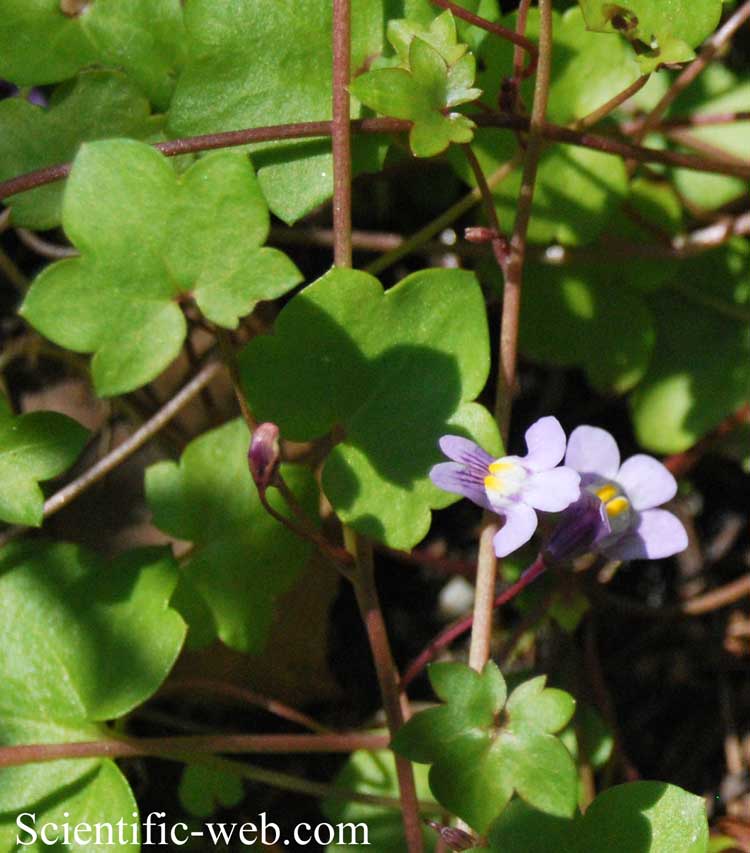
Cymbalaria muralis, Photo: Michael Lahanas
Classification System: APG IV
Superregnum: Eukaryota
Regnum: Plantae
Cladus: Angiosperms
Cladus: Eudicots
Cladus: Core eudicots
Cladus: Asterids
Cladus: Lamiids
Ordo: Lamiales
Familia: Plantaginaceae
Tribus: Antirrhineae
Subtribus: Antirrhininae
Genus: Cymbalaria
Species: Cymbalaria muralis
Subspecies: C. m. subsp. muralis – C. m. subsp. pubescens – C. m. subsp. visianii
Name
Cymbalaria muralis G.Gaertn., B.Mey. & Scherb., Oekon. Fl. Wetterau 2: 397 (1800).
Synonyms
Replaced synonym
Antirrhinum cymbalaria L., Sp. Pl. 2: 612 (1753).
Homotypic
Antirrhinum hederaceum Lam., Fl. Franç. 2: 338 (1779), nom. illeg.
Antirrhinum hederifolium Salisb., Prodr.: 98 (1796), nom. illeg.
Cymbalaria cymbalaria Wettst. in Engler & Prantl, Nat. Pflanzenfam. 4(3b): 58 (1891), nom. inadmiss.
Cymbalaria hederacea Gray, Nat. Arr. Brit. Pl. 2: 322 (1821), nom. illeg.
Elatine cymbalaria (L.) Moench, Meth. : 525 (1794).
Linaria cymbalaria (L.) Mill., Gard. Dict. ed. 8 n.º 17. 1768.
References
Gaertner, G., Meyer, B. & Scherbius, J. 1800. Oekon. Fl. Wetterau 2: 397.
Vernacular names
čeština: Zvěšinec zední
dansk: Vedbend-Torskemund
Deutsch: Zimbelkraut
English: Ivy-leaved Toadflax
español: Palomilla de muro
suomi: Rauniokilkka
français: Cymbalaire des murs
Gàidhlig: Buabh-lìon Eidheannach
hornjoserbsce: Pomurny lenčk
italiano: Ciombolino comune
日本語: ツタバウンラン
Nederlands: Muurleeuwenbek
polski: Cymbalaria bluszczykowata
slovenčina: Cimbalok múrový
svenska: Murreva
Cymbalaria muralis, with common names ivy-leaved toadflax,[3] Kenilworth ivy,[4] coliseum ivy,[4] Oxford ivy,[4] mother of thousands,[4] pennywort,[4] wandering sailor,[4] is a flowering plant in the family Plantaginaceae native to Mediterranean Europe and widely naturalised elsewhere.
Description and habitat
It spreads quickly, growing up to 5 cm (2.0 in) tall – it commonly grows in rock and wall crevices, and along footpaths. The leaves are evergreen, rounded to heart-shaped, 2.5 to 5 cm (1.0 to 2.0 in) long and wide, 3–7-lobed, alternating on thin stems. The flowers are very small but distinctly spurred, similar in shape to snapdragon flowers.[5] Flowers from May to September.[6]
Distribution
Here growing on a tree for support, Auckland, NZ
Cymbalaria muralis is native to south and southwest Europe, the Southern Alps, eastern Yugoslavia, southern Italy and Sicily.[7][8] It has spread throughout the world as an invasive plant, including the United States,[9] the British Isles,[10] Australia[11][12][13] and New Zealand.[13][14]
It is said to have been introduced into England by accident when a shipment of sculptures was brought to Oxford. It was first introduced early in the 17th century and was widely planted in the UK up to the 19th century.[15]
Reproduction
This plant has an unusual method of propagation. The flower stalk is initially positively phototropic and moves towards the light. After fertilisation, it becomes negatively phototropic ("scototropic") and moves away from the light. This results in seed being pushed into dark crevices of rock walls, where it is more likely to germinate.[16]
References
GBIF.org (26 May 2018) GBIF Occurrence Download https://doi.org/10.15468/dl.85brwi Cymbalaria muralis P.Gaertner, B.Meyer & Scherb.
"The Plant List: A Working List of All Plant Species". Retrieved 9 February 2015.
BSBI List 2007 (xls). Botanical Society of Britain and Ireland. Archived from the original (xls) on 2015-06-26. Retrieved 2014-10-17.
"Cymbalaria muralis". Germplasm Resources Information Network (GRIN). Agricultural Research Service (ARS), United States Department of Agriculture (USDA). Retrieved 9 February 2015.
David S. MacKenzie (2002). Perennial Ground Covers. Timber Press. p. 121. ISBN 978-0-88192-557-9.
Webb, D.A., Parnell, J. and Doogue, D. 1996. An Irish Flora. Dundalgan Press (W. Tempest) Ltd. Dundalk/. ISBN 0-85221-131-7
Mariola Truchan; Zbigniew Sobisz (2006). "Distribution of Cymbalaria muralis P. Gaertn., B. Mey. & Scherz. in the central part of Polish Pomerania" (PDF). Biodiversity Research and Conservation. 1–2: 98–101.
Ewa Szczęśniak; Krzysztof Świerkosz (2003). "Cymbalaria muralis P. Gaertn., B. Mey. & Schreb. and Cymbalarietum muralis Görs 1966 in Lower Silesia – expansion or regression?". In A. Zając; M. Zając; B. Zemanek (eds.). Phytogeographical Problems of Synanthropic Plants. Jagiellonian University. pp. 185–193. ISBN 8391516148.
"Cymbalaria muralis". USDA Plants Profile. United States Department of Agriculture. Retrieved 30 June 2013.
A. R. Clapham; T. G. Tutin; E. F. Warburg (1968). Excursion Flora of the British Isles. Cambridge University Press. ISBN 0-521-04656-4.
Florabase: "Cymbalaria muralis". Accessed 5 April 2018.
Barker, R.W. "Cymbalaria muralis". National Herbarium of NSW, Royal Botanic Garden, Sydney, Australia. Accessed 5 April 2018.
Australia's Virtual Herbarium: "Cymbalaria muralis". Accessed 5 April 2018.
Webb, C.J., Sykes, W.R., Garnock-Jones, P.J. 1988. "NZ Flora: Cymbalaria muralis". Flora of New Zealand Volume IV Naturalised Pteridophytes, Gymnosperms, Dicotyledons, Botany Division, DSIR, Christchurch. Accessed 5 April 2018.
Mabey, R; Flora Britannica, London 1996, ISBN 9781856193771
James Watnell Hart (1990). Plant Tropisms and other Growth Movements. Springer. p. 101. ISBN 978-0-412-53080-7.
Retrieved from "http://en.wikipedia.org/"
All text is available under the terms of the GNU Free Documentation License

